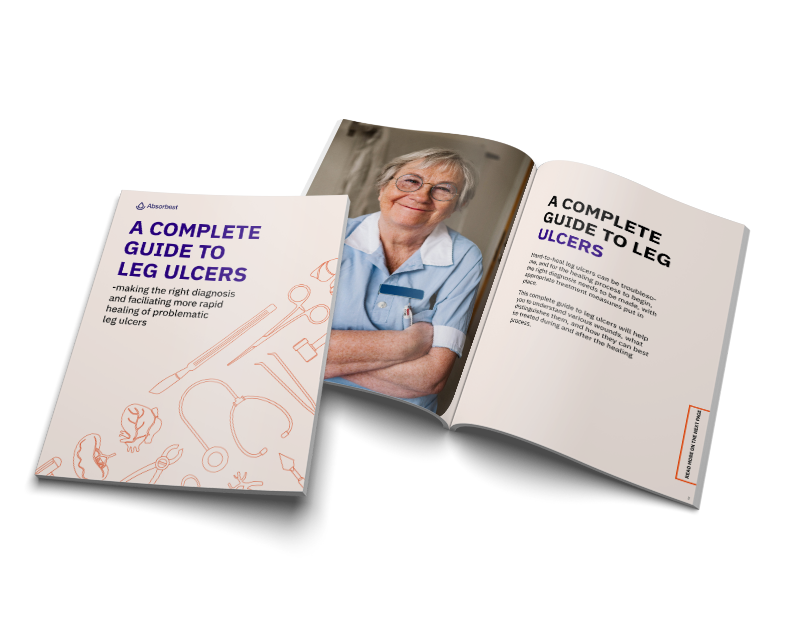Mixed aetiology leg ulcers are complex wounds caused by both venous and arterial disease. These wounds are becoming increasingly common and can be particularly challenging for healthcare professionals. Due to their unique nature, a precise diagnosis and a tailored treatment strategy are essential.
This article highlights what mixed aetiology ulcers are, their underlying causes, treatment approaches, and the symptoms and distinguishing characteristics that can help guide effective care.
Several triggering factors and underlying health conditions can contribute to the development of mixed aetiology ulcers. Often, the patient already has a venous ulcer—either recurrent or a hard-to-heal wound. Over time, the risk increases for developing arterial insufficiency, ultimately resulting in a mixed aetiology ulcer.
Risk factors for ulcer development include age, smoking, diabetes, hypertension, and a sedentary lifestyle. These factors can impair both venous and arterial circulation and contribute to the onset of mixed aetiology ulcers.
Venous ulcers are typically caused by venous insufficiency, where damaged or dysfunctional venous valves prevent proper blood return to the heart. This leads to blood and lymphatic fluid pooling in the lower extremities, causing swelling and increased pressure that can damage the skin from the inside out, resulting in ulceration.
Arterial insufficiency, also known as arterial circulatory disorder, is most often due to atherosclerosis—a thickening and narrowing of the arteries caused by plaque buildup. This reduces blood flow and oxygen supply to the tissues, leading to thin, fragile skin that is more prone to breakdown and ulcer formation.
Accurate diagnosis is crucial for the successful treatment of mixed aetiology ulcers. It is important to distinguish between venous and arterial insufficiency to understand how the wound is affected and to determine the appropriate treatment. Common diagnostic methods include thorough physical examinations, patient medical history (anamnesis), and sometimes diagnostic tests.
Mixed aetiology ulcers can vary in appearance depending on the patient’s specific combination of venous and arterial insufficiency, each of which has distinct features. Typically, mixed aetiology ulcers are characterized by swelling (edema), changes in wound color, necrotic tissue, and pain. The wound area may be moist and difficult to heal.
Depending on the degree of venous and arterial insufficiency, mixed aetiology ulcers can vary in severity in terms of healing. The wounds may be deep and slow to heal, and may recur if not properly treated and maintained.
In venous insufficiency, symptoms may include itching, heaviness in the legs and ankles, and increased swelling after prolonged sitting or standing. In arterial insufficiency, patients typically experience pain in the legs or ankles, especially during physical activity, which is relieved or ceases at rest.
Symptoms of mixed aetiology ulcers can therefore be a combination of those commonly seen in venous and arterial ulcers, making diagnosis more complex. Typical symptoms include pain, swelling, blood pooling, dry skin, color changes in the wound (often reddish-brown or purplish-red), necrotic tissue, and possible infection. Prompt and accurate diagnosis of mixed aetiology ulcers is important, as early diagnosis and treatment can prevent serious complications and promote wound healing.
Effective treatment of mixed aetiology ulcers requires a holistic, individualized approach that addresses both the venous and arterial issues. The main goals of treatment are to improve wound healing, relieve pain, control any infection, and prevent recurrence.
Here are some key treatment methods for mixed aetiology ulcers:
Careful wound cleaning and removal of necrotic tissue and biofilm are important to promote healing. Customized modern dressings, such as superabsorbent dressings, can support wound healing and effectively manage bacteria. Additionally, they help manage excess wound exudate by locking it inside the core of the dressing. This reduces the risk of leakage and maceration of the surrounding skin, which can otherwise occur, especially under pressure such as compression therapy.
For venous ulcers, compression therapy is an important treatment method. This involves applying external pressure to the wound area to improve blood circulation and reduce swelling. Compression bandages or elastic stockings can be used to help restore venous function.
For mixed aetiology ulcers where arterial insufficiency is present, compression therapy must always be prescribed by a physician.
In some cases, surgical or interventional procedures may be necessary to improve blood flow in the affected area. This can involve opening or widening narrowed blood vessels or performing bypass surgery to redirect blood flow.
Pain associated with mixed aetiology ulcers can often be intense and requires appropriate pain relief. Medications or other methods may be used to help the patient manage pain effectively. Here you can find more information about pain and various pain assessment tools.
Mixed aetiology ulcers, involving both venous and arterial insufficiency, pose a challenge for both healthcare professionals and patients.
Accurate diagnosis and an individualized, holistic treatment strategy are essential for achieving positive outcomes. By understanding the causes of mixed aetiology ulcers, their symptoms, and appropriate treatment methods, you can help patients heal faster and prevent complications. Early detection and correct treatment are key to managing mixed aetiology ulcers and improving patients’ quality of life. Continued research and knowledge sharing can further enhance care and quality of life for individuals affected by mixed aetiology ulcers.

Our “Complete Guide to leg ulcers” focuses primarily on hard-to-heal venous leg ulcers.
Get guiding about treatment measures, healing phases, cleaning, and appropriate dressings, which can affect and drive the long-term healing process.
Harding K, et al. Simplifying venous leg ulcer management: Consensus recommendations. Wounds International, 2015. Available at: www.woundsinternational.com
Vårdhandboken [The Healthcare Manual], Christina Lindholm, MD, Professor, Sophiahemmet University, Stockholm. Available at: www.vardhandboken.se
Lindholm C. Wounds. 4th ed., Studentlitteratur AB, 2018